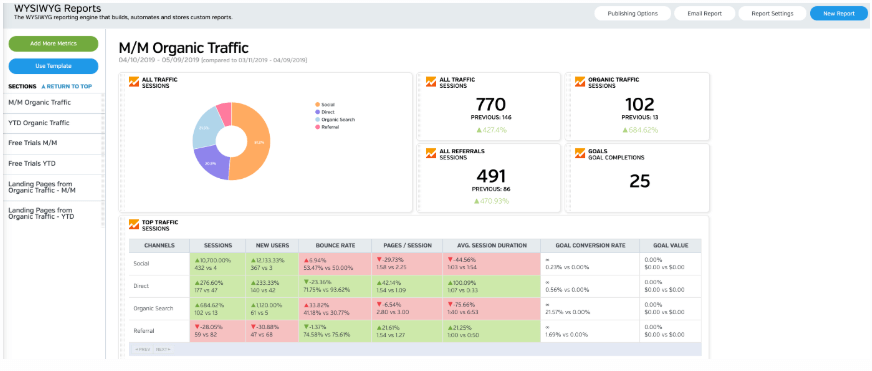Google Analytics has long been the go-to website statistics program for businesses of all sizes. But there’s a new keyword in town, and (not provided) isn’t going away anytime soon.
This “keyword” represents any and all keywords used by website readers who found your website through a Google search query while logged into their Google Account.
When Google made the announcement that it would begin “protecting” personalized search results by removing this data, business owners and web marketers everywhere could be heard screaming and tearing their hair out.
But the months following the (not provided) announcement have given me the opportunity to dig deeper into Google Analytics in order to analyze results for my SEO clients.
Since we can no longer rely on Google Analytics to provide us with a complete list of keywords that drive organic traffic, here are some other metrics that allow us to draw correlations about the health and effectiveness of our SEO programs.
Landing pages
This has always been a good metric for understanding how people are entering your website – that’s important, because it can help you determine which pages in your website have the best rankings and backlinks. Even more interesting is evaluating the number of landing pages in a given period, and how that number changes over time.
If you’re performing natural SEO on a website and you see that the number of landing pages is increasing, you may be able to make the assumption that your optimization is helping those internal pages become more visible.
Average visit duration
Using this metric alone isn’t very valuable – it’s too broad and has too much room for unintentional user manipulation. I mean, who amongst us haven’t visited a website and then left the room without closing our browser, only to return 15 minutes later and continue navigating the website?
But used in conjunction with other metrics, such as landing pages, average visit duration is a beneficial Google Analytics metric to gauge the effectiveness of an online marketing campaign.
For example, if you find that a popular landing page has abnormally low average visit duration when compared with your site average, it may be that while your page is optimized for certain keywords, it isn’t effectively delivering your message to readers. In this way you can identify pages that are or are not working on your website and act accordingly.
Audience
Although Google Analytics doesn’t provide any personal information about your readers, it gives you even more useful information – like their city and state, device and operating system, and their status as a new or returning visitor. This data can be beneficial in a variety of ways, depending on what your website is trying to achieve.
- Geography: If your business operates in a certain geographical area and you find that your readers are primarily coming from that area – chances are you’re doing something right.
- Devices: Mobile traffic on the rise? Maybe it’s time to consider a new mobile website. Or you may have a mobile website and see that your mobile traffic isn’t changing – that could be a sign that it’s for some good mobile SEO.
- Returning versus new visitors: Depending on your business model, your bread and butter may be one or the other. Evaluating whether or not people are returning to your website again and again may be beneficial.
Once again, tie this information together with things like average visit duration and landing pages and you can start to determine some really interesting patterns that may turn out to be more informative than a simple list of keywords ever was.
Got a little more time? Try these
Other useful features available with a little bit more effort include Event Tracking and URL tracking.
- Event Tracking: Event tracking can be a bit tricky to implement but can offer some interesting insights about how people engage with your website beyond just clicking on links – are they watching your embedded videos? Are they browsing your flash photo gallery? Are they clicking on your social media links?
- URL tracking: URL tracking is a great tool – if you’re using social media, email marketing, shopping engines or other methods to promote your website, consider implementing URL tracking. It will help you keep accurate track of the sources that are sending actual traffic to your website.
Don’t forget Webmaster Tools
While (not provided) makes Google Analytics less useful for many marketers, you have another option within Google’s suite of products to help you understand the keywords that are delivering visitors. In Google Webmaster Tools, you can find the top 1,000 search queries that have delivered traffic to your website in the last 30 days.
In another article about keyword (not provided) I suggest linking Google Analytics and Google Webmaster Tools accounts in order to leverage the new relationship between the two.
If (not provided) has taught us anything, it’s that Internet marketing is so much more than SEO. And look on the bright side: Now you know how many people are finding your site while logged into their Google account. Maybe they’ll even give you a +1.

White Labeled and Branded Reports. Drag and Drop Editor. Automate your SEO, PPC, Social, Email, and Call Tracking Reporting.





Great article to help battle that pesky (not provided). Thanks for the tips!
Thank you! It’s challenging, but we have to be creative and pull everything we can out of GA – so many correlations can be drawn. And although keywords were SUPER NICE to have – it seems to me that this omission has led to me having a deeper understanding of our statistics.